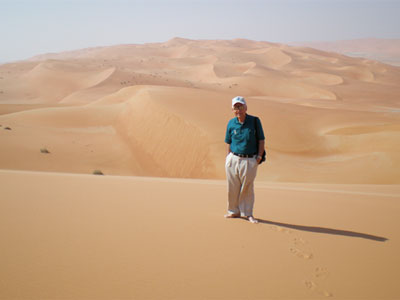 Farouk El-Baz, Ph.D., director of the Boston University Center for Remote Sensing, is the recipient of the 2013 Ireland Distinguished Visiting Scholar Award.
Farouk El-Baz, Ph.D., director of the Boston University Center for Remote Sensing, is the recipient of the 2013 Ireland Distinguished Visiting Scholar Award.
El-Baz conducts and directs basic scientific research in the field of remote sensing. Emphasis is placed on arid lands, because less is known about them than the humid regions of the Earth, and particularly the use of remote sensing in the location of groundwater resources. He also has conducted research on surface features of solar system planets as part of comparative planetology.
El-Baz will deliver a free, public lecture titled “Origins of Ancient Egyptian Civilization” at 6 p.m., Monday, March 4, in the Jemison Concert Hall. A public reception will be held immediately after the lecture.
El-Baz, a native of Zagazig, Egypt, became a U.S. citizen in April 1970. He holds degrees from Ain Shams University in Cairo, Egypt, the Missouri School of Mines and Metallurgy, and the University of Missouri at Rolla. He was nominated for the Ireland Award by Sarah Parcak, Ph.D., associate professor of anthropology.
“Professor El-Baz is a globally recognized scientist and human being,” Parcak says. “He has more than 50 years of experience conducting research in geology, archaeology, remote sensing and space exploration for NASA. His work has impacted diverse scientific fields, and he is a respected advocate for peace and understanding in the Middle East following the Arab Spring.”
| El Baz was one of the first researchers to use satellite imagery to locate archaeological features in Egypt, which is one of his many areas of interest, and it caught the attention of a young Sarah Parcak who has used the technique to uncover — from space — ancient sites from around the world that were thought to be lost forever. Parcak is now considered a world leader in the field, spurred in part by El Baz. |
As part of his duties at Boston University, El-Baz manages all activities of the Center for Remote Sensing, a scientific research organization affiliated with the Departments of Archaeology, Earth Sciences and Geography & Environment. Its management includes handling of research programs, scientific publications, research funds and personnel and graduate student matters.
Prior to joining Boston University in 1986, El-Baz was vice president for science and technology at Itek Optical Systems. While there he led strategic planning for technology utilization of high resolution imaging systems that were developed for utilization of the Large Format Camera (LFC) on space shuttle missions for the National Aeronautics & Space Administration.
El-Baz also worked as research director for the Center for Earth & Planetary Studies at the National Air & Space Museum at the Smithsonian Institution from 1973-1982. In addition to establishing the center, El-Baz led research efforts into desert environments around the world with emphasis on the applications of space data to the understanding of the origin and evolution of arid landforms in space and time.
El Baz was one of the first researchers to use satellite imagery to locate archaeological features in Egypt, which is one of his many areas of interest, and it caught the attention of a young Parcak who has used the technique to uncover — from space — ancient sites from around the world that were thought to be lost forever. Parcak is now considered a world leader in the field, spurred in part by El Baz.
“I’ve been reading his papers since I was an undergraduate,” Parcak says. “I wrote to him in my senior year of college — and I was shocked that he wrote me back. It made an enormous impression that a scholar with such a huge international reputation would take time to encourage a young student. It speaks to his humanity — something for which he is also famous.”
Each year the Ireland Award brings internationally renowned scholars in the arts and sciences to UAB to present a public lecture and participate in campus activities. The prize is made possible through an endowment established by Caroline P. and Charles W. Ireland.
